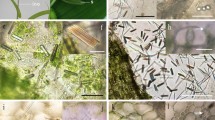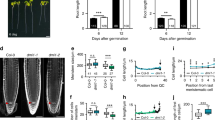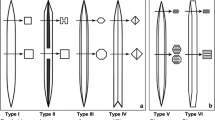Summary
Crystal idioblasts are cells which are specialized for accumulation of Ca2+ as a physiologically inactive, crystalline salt of oxalic acid. Using microautoradiographic, immunological, and ultrastructural techniques, the process of raphide crystal growth, and how crystal growth is coordinated with cell growth, was studied in idioblasts ofPistia stratiotes. Incorporation of45Ca2+ directly demonstrated that, relative to surrounding mesophyll cells, crystal idioblasts act as high-capacity Ca2+ sinks, accumulating large amounts of Ca2+ within the vacuole as crystals. The pattern of addition of Ca2+ during crystal growth indicates a highly regulated process with bidirectional crystal growth. In very young idioblasts,45Ca2+ is incorporated along the entire length of the needle-shaped raphide crystals, but as they mature incorporation only occurs at crystal tips in a bidirectional mode. At full maturity, the idioblast stops Ca2+ uptake, although the cells are still alive, demonstrating an ability to strictly regulate Ca transport processes at the plasma membrane. In situ hybridization for ribosomal RNA shows young idioblasts are extremely active cells, are more active than older idioblasts, and have higher general activity than surrounding mesophyll cells. Polarizing and scanning electron microscopy demonstrate that the crystal morphology changes as crystals develop and includes morphological polarity and an apparent nucleation point from which crystals grow bidirectionally. These results indicate a carefully regulated process of biomineralization in the vacuole. Finally, we show that the cytoskeleton is important in controlling the idioblast cell shape, but the regulation of crystal growth and morphology is under a different control mechanism.
Similar content being viewed by others
Abbreviations
- SEM:
-
scanning electron microscopy
References
Arnott HJ, Pautard AR (1970) Calcification in plants. In: Schraer H (ed) Biological calcification. Appleton Crofts, New York, pp 375–446
Borchert R (1985) Calcium-induced patterns of calcium-oxalate crystals in isolated leaflets ofGleditsia triacanthos L. andAlbizia julibrissin Durazz. Planta 165: 301–310
— (1986) Calcium acetate induces calcium uptake and formation of calcium-oxalate crystals in isolated leaflets ofGleditsia triacanthos L. Planta 168: 571–578
Foster AS (1956) Plant idioblasts: remarkable examples of cell specialization. Protoplasma 46: 184–193
Franceschi VR (1984) Developmental features of calcium oxalate crystal sand deposition inBeta vulgaris L. leaves. Protoplasma 120: 216–223
— (1989) Calcium oxalate formation is a rapid and reversible process inLemna minor. Protoplasma 148: 130–137
—, Horner HT Jr (1980) Calcium oxalate crystals in plants. Bot Rev 46: 361–427
—, Loewus FA (1995) Oxalate synthesis and function in plants and fungi. In: Khan SR (ed) Calcium oxalate in biological systems. CRC Press, Boca Raton, Fla, pp 113–130
—, Schuren AM (1986) Incorporation of strontium into plant calcium oxalate crystals. Protoplasma 30: 199–205
—, Li X, Zhang D, Okita TW (1993) Casequestrinlike calcium binding protein is expressed in calcium accumulating cells ofPistia stratiotes Proc Natl Acad Sci USA 90: 6986–6990
Frey-Wyssling A (1981) Crystallography of the two hydrates of crystalline calcium oxalate in plants. Am J Bot 68: 130–141
Gallaher RN (1975) The occurrence of calcium in plant tissues as crystals of calcium oxalate. Commun Soil Sci Plant Anal 6: 315–330
Giddings TH, Staehelin LA (1988) Spatial relationship between microtubules and plasma-membrane rosettes during the deposition of primary wall microfibrils inClosterium sp. Planta 173: 22–30
Goddard RH, Wick SM, Silflow CD, Sunstad DP (1994) Microtubule components of the plant cell cytoskeleton. Plant Physiol 104: 1–6
Gunning BES, Hardham AR (1982) Microtubules. Annu Rev Plant Physiol 33: 651–698
Horner HT Jr, Wagner BL (1980) The association of druse crystals with the developing stomium ofCapsicum annuum (Solanaceae) anthers. Am J Bot 67: 1347–1360
— — (1995) Calcium oxalate formation in higher plants. In: Khan SR (ed) Calcium oxalate in biological systems. CRC Press, Boca Raton, Fla, pp 53–72
—, Whitmoyer R (1972) Raphide crystal cell development in leaves ofPyschotria punctata (Rubiaceae). J Cell Sci 11: 339–355
Keates SE, Tarlyn NM, Loewus FA, Franceschi VR (2000) L-Ascorbic acid and L-galactose are sources for oxalic acid and calcium oxalate inPistia stmtiotes. Phytochemistry 53: 433–440
Libert B, Franceschi VR (1987) Oxalate in crop plants. J Agric Food Chem 35: 926–938
Lloyd CW (1987) The plant cytoskeleton: the impact of fluorescence microscopy. Annu Rev Plant Physiol 38: 119–139
Quitadamo IJ, Kostman TA, Schelling ME, Franceschi VR (2000) Magnetic bead purification as a rapid and efficient method for enhanced antibody specificity for plant sample immunoblotting and immunolocalization. Plant Sci 153: 7–14
Slocum RD, Roux SJ (1982) Cellular and subcellular localization of calcium in gravistimulated oat coleoptiles and its possible significance in the establishment of tropic curvature. Planta 157: 481–492
Spurr AR (1969) A low-viscosity epoxy resin embedding medium for electron microscopy. J Ultrastruct Res 26: 31–43
Sylvester AW, Williams MH, Green PB (1989) Orientation of cortical microtubules correlates with cell shape and division direction. Protoplasma 153: 91–103
Tarlyn N, Kostman TA, Nakata PA, Keates SE, Franceschi VR (1998) Axenic culture ofPistia stratiotes for use in plant biochemical studies. Aquat Bot 60: 161–168
Webb MA, Arnott HJ (1983) Inside plant crystals: a study of the non-crystalline core in druses inVitis vinifera endosperm. Scanning Electron Microsc 4: 1759–1770
—, Cavaletto NC, Carpita NC, Lopez LE, Arnott HJ (1995) The intravacuolar organic matrix associated with calcium oxalate crystals in leaves ofVitis. Plant J 7: 633–648
Zhang D, Li X, Lynch-Holm V, Okita TW, Franceschi VR (1994) High capacity sequestration in plant cells is mediated by vacuolar Ca binding protein. Plant Physiol 105: 56
Author information
Authors and Affiliations
Rights and permissions
About this article
Cite this article
Kostman, T.A., Franceschi, V.R. Cell and calcium oxalate crystal growth is coordinated to achieve high-capacity calcium regulation in plants. Protoplasma 214, 166–179 (2000). https://doi.org/10.1007/BF01279061
Received:
Accepted:
Issue Date:
DOI: https://doi.org/10.1007/BF01279061




